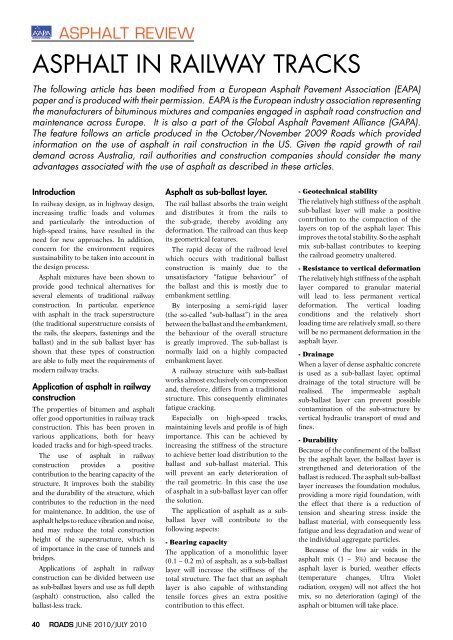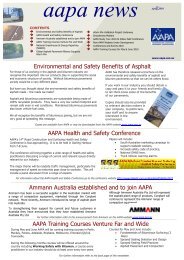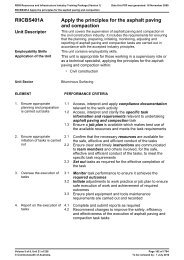Asphalt Review - Volume 29 Number 2 (June / July 2010)
Asphalt Review - Volume 29 Number 2 (June / July 2010)
Asphalt Review - Volume 29 Number 2 (June / July 2010)
You also want an ePaper? Increase the reach of your titles
YUMPU automatically turns print PDFs into web optimized ePapers that Google loves.
ASPHALT REVIEW<br />
<strong>Asphalt</strong> in Railway Tracks<br />
The following article has been modified from a European <strong>Asphalt</strong> Pavement Association (EAPA)<br />
paper and is produced with their permission. EAPA is the European industry association representing<br />
the manufacturers of bituminous mixtures and companies engaged in asphalt road construction and<br />
maintenance across Europe. It is also a part of the Global <strong>Asphalt</strong> Pavement Alliance (GAPA).<br />
The feature follows an article produced in the October/November 2009 Roads which provided<br />
information on the use of asphalt in rail construction in the US. Given the rapid growth of rail<br />
demand across Australia, rail authorities and construction companies should consider the many<br />
advantages associated with the use of asphalt as described in these articles.<br />
Introduction<br />
In railway design, as in highway design,<br />
increasing traffic loads and volumes<br />
and particularly the introduction of<br />
high-speed trains, have resulted in the<br />
need for new approaches. In addition,<br />
concern for the environment requires<br />
sustainability to be taken into account in<br />
the design process.<br />
<strong>Asphalt</strong> mixtures have been shown to<br />
provide good technical alternatives for<br />
several elements of traditional railway<br />
construction. In particular, experience<br />
with asphalt in the track superstructure<br />
(the traditional superstructure consists of<br />
the rails, the sleepers, fastenings and the<br />
ballast) and in the sub ballast layer has<br />
shown that these types of construction<br />
are able to fully meet the requirements of<br />
modern railway tracks.<br />
Application of asphalt in railway<br />
construction<br />
The properties of bitumen and asphalt<br />
offer good opportunities in railway track<br />
construction. This has been proven in<br />
various applications, both for heavy<br />
loaded tracks and for high-speed tracks.<br />
The use of asphalt in railway<br />
construction provides a positive<br />
contribution to the bearing capacity of the<br />
structure. It improves both the stability<br />
and the durability of the structure, which<br />
contributes to the reduction in the need<br />
for maintenance. In addition, the use of<br />
asphalt helps to reduce vibration and noise,<br />
and may reduce the total construction<br />
height of the superstructure, which is<br />
of importance in the case of tunnels and<br />
bridges.<br />
Applications of asphalt in railway<br />
construction can be divided between use<br />
as sub-ballast layers and use as full depth<br />
(asphalt) construction, also called the<br />
ballast-less track.<br />
<strong>Asphalt</strong> as sub-ballast layer.<br />
The rail ballast absorbs the train weight<br />
and distributes it from the rails to<br />
the sub-grade, thereby avoiding any<br />
deformation. The railroad can thus keep<br />
its geometrical features.<br />
The rapid decay of the railroad level<br />
which occurs with traditional ballast<br />
construction is mainly due to the<br />
unsatisfactory “fatigue behaviour” of<br />
the ballast and this is mostly due to<br />
embankment settling.<br />
By interposing a semi-rigid layer<br />
(the so-called “sub-ballast”) in the area<br />
between the ballast and the embankment,<br />
the behaviour of the overall structure<br />
is greatly improved. The sub-ballast is<br />
normally laid on a highly compacted<br />
embankment layer.<br />
A railway structure with sub-ballast<br />
works almost exclusively on compression<br />
and, therefore, differs from a traditional<br />
structure. This consequently eliminates<br />
fatigue cracking.<br />
Especially on high-speed tracks,<br />
maintaining levels and profile is of high<br />
importance. This can be achieved by<br />
increasing the stiffness of the structure<br />
to achieve better load distribution to the<br />
ballast and sub-ballast material. This<br />
will prevent an early deterioration of<br />
the rail geometric. In this case the use<br />
of asphalt in a sub-ballast layer can offer<br />
the solution.<br />
The application of asphalt as a subballast<br />
layer will contribute to the<br />
following aspects:<br />
- Bearing capacity<br />
The application of a monolithic layer<br />
(0.1 – 0.2 m) of asphalt, as a sub-ballast<br />
layer will increase the stiffness of the<br />
total structure. The fact that an asphalt<br />
layer is also capable of withstanding<br />
tensile forces gives an extra positive<br />
contribution to this effect.<br />
- Geotechnical stability<br />
The relatively high stiffness of the asphalt<br />
sub-ballast layer will make a positive<br />
contribution to the compaction of the<br />
layers on top of the asphalt layer. This<br />
improves the total stability. So the asphalt<br />
mix sub-ballast contributes to keeping<br />
the railroad geometry unaltered.<br />
- Resistance to vertical deformation<br />
The relatively high stiffness of the asphalt<br />
layer compared to granular material<br />
will lead to less permanent vertical<br />
deformation. The vertical loading<br />
conditions and the relatively short<br />
loading time are relatively small, so there<br />
will be no permanent deformation in the<br />
asphalt layer.<br />
- Drainage<br />
When a layer of dense asphaltic concrete<br />
is used as a sub-ballast layer, optimal<br />
drainage of the total structure will be<br />
realised. The impermeable asphalt<br />
sub-ballast layer can prevent possible<br />
contamination of the sub-structure by<br />
vertical hydraulic transport of mud and<br />
fines.<br />
- Durability<br />
Because of the confinement of the ballast<br />
by the asphalt layer, the ballast layer is<br />
strengthened and deterioration of the<br />
ballast is reduced. The asphalt sub-ballast<br />
layer increases the foundation modulus,<br />
providing a more rigid foundation, with<br />
the effect that there is a reduction of<br />
tension and shearing stress inside the<br />
ballast material, with consequently less<br />
fatigue and less degradation and wear of<br />
the individual aggregate particles.<br />
Because of the low air voids in the<br />
asphalt mix (1 – 3%) and because the<br />
asphalt layer is buried, weather effects<br />
(temperature changes, Ultra Violet<br />
radiation, oxygen) will not affect the hot<br />
mix, so no deterioration (aging) of the<br />
asphalt or bitumen will take place.<br />
40 ROADS JUNE <strong>2010</strong>/JULY <strong>2010</strong>

















